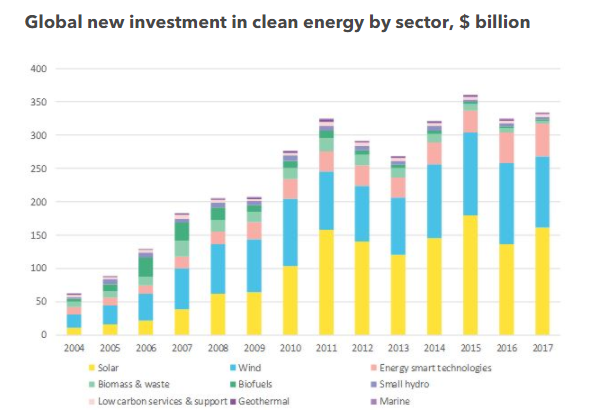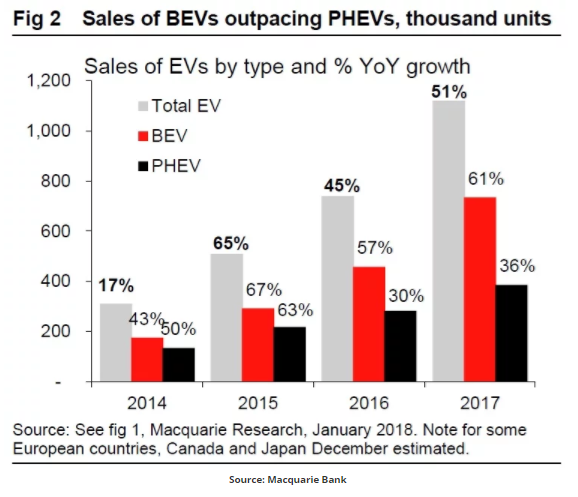Despite policy opposition from fossil fuel backers across the world, renewable energy adoption rates rapidly accelerated during 2017 as both renewable electricity generation and clean energy vehicles saw considerable growth. This rapid growth is providing an opportunity for an early peak in global carbon emissions so long as investment in and broader policy support for clean energy continues to advance.
Solar Leads Record Year for New Renewable Power Generation
At the grid level, the biggest gains came from solar which saw an estimated 98 GW added globally. This is a 31 percent jump YOY from 2016 when 76.2 GW of solar energy was installed. More than half of this new solar generating capacity (52.83 GW) was added by China — now the undisputed solar leader both in terms of manufacturing and installations. That said, large gains were also made by India, Europe and the U.S. even as the rest of the world saw broader adoption as panel prices continued to fall. Uncertainty in the U.S. over the 201c trade case brought by Sunivia and enabled by the Trump Administration hampered solar adoption there. However, it is estimated that about 12 GW were still installed. Australia also saw a solar renaissance with more than 1 GW installed during 2017 as fossil-fuel based power generation prices soared and panel prices continued to plummet.
(Solar energy’s versatility combined with falling prices generates major advantages. In the coming years, solar glass will make this clean power source even more accessible.)
Wind energy also saw major additions in the range of 56 GW during 2017. Though less than banner year 2015 at 60 GW, wind grew from an approximate 50 GW annual add in 2016. This clean power source is therefore still showing a healthy adoption rate despite competition from dirty sources like natural gas and cheap coal due to overcapacity. Other renewable energy additions such as large hydro power, small hydro, biofuels, and geothermal likely resulted in another 30 GW or more– with China alone adding 12.8 GW of new large hydro power capacity.
Overall, about 185 GW of new clean electricity appears to have been added to global generation during 2017 — outpacing both new nuclear and new fossil fuels. This compares to approximately 150 GW from similar sources added during 2016. The primary drivers of this very rapid addition were swiftly falling solar costs, continued drops in wind prices, a number of policy incentives for clean energy adoption, rising access to energy storage systems and increasing concerns over human-caused climate change.
(More bang for your buck. Despite a plateau in clean energy investment over recent years, annual capacity additions keep rising — primarily due to continuously falling wind and solar prices. Image source: Bloomberg New Energy Finance.)
Electrical Vehicles Boom
Even as clean power generation was making strides, clean transport was racing ahead. With new offerings like the Chevy Bolt, the Tesla Model 3, and the upgraded Nissan Leaf, the electrical vehicle appears to have come of age. Luxury EVs are now more and more common in places like Europe and the United States even as mid-priced EVs are becoming widely available. Concern over both clean air and climate change is driving large cities and even major countries like India and China to pursue fossil fuel vehicle bans. A growing number of EVs with range capabilities in excess of 200 miles are hitting markets. And charging infrastructure is both growing and improving. As a result of these multiple dynamics, EV sales grew by nearly 50 percent from about 740,000 sold in 2016 to 1.1 million sold in 2017.
Renewables + EVs Bring Potential For Early Peak in Carbon Emissions
Such rapid rates of renewable energy adoption are starting to have an impact on human carbon emissions. Annual rates of renewable power addition in the range of 150 to 250 GW are enough to begin to plateau and/or reduce global carbon emission so long as reasonable efficiencies are added to the energy system. Meanwhile, annual EV sales in the range of 3 to 5 million per year and growing around 20 percent annually is enough to start to tamp down global oil demand and related externalities.
(Very rapid EV sales growth during 2017 is likely to be repeated in 2018 as more capable and less expensive electrical vehicles like Tesla’s Model 3 hit markets in larger numbers. Image source: Macquarie Bank and Business Insider.)
We are beginning to enter the range of visible fossil fuel replacement by renewable power generation now and it appears that EVs will start to measurably impact oil demand by the early 2020s. To this point, direct replacement of coal with renewable and natural gas based energy sources during recent years has resulted in a considerable slowing in the rate of carbon emissions growth. If renewables continue to make substantial gains during 2018 and onward, this trend of replacement of fossil fuels and reduction of harmful greenhouse gasses hitting the atmosphere will become more and more apparent.















